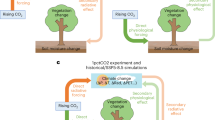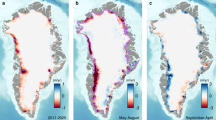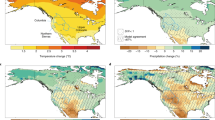Abstract
Continental runoff has increased through the twentieth century1,2 despite more intensive human water consumption3. Possible reasons for the increase include: climate change and variability, deforestation, solar dimming4, and direct atmospheric carbon dioxide (CO2) effects on plant transpiration5. All of these mechanisms have the potential to affect precipitation and/or evaporation and thereby modify runoff. Here we use a mechanistic land-surface model6 and optimal fingerprinting statistical techniques7 to attribute observational runoff changes1 into contributions due to these factors. The model successfully captures the climate-driven inter-annual runoff variability, but twentieth-century climate alone is insufficient to explain the runoff trends. Instead we find that the trends are consistent with a suppression of plant transpiration due to CO2-induced stomatal closure. This result will affect projections of freshwater availability, and also represents the detection of a direct CO2 effect on the functioning of the terrestrial biosphere.
This is a preview of subscription content, access via your institution
Access options
Subscribe to this journal
Receive 51 print issues and online access
$199.00 per year
only $3.90 per issue
Buy this article
- Purchase on Springer Link
- Instant access to full article PDF
Prices may be subject to local taxes which are calculated during checkout



Similar content being viewed by others
References
Labat, D., Godderis, Y., Probst, J. L. & Guyot, J. L. Evidence for global runoff increase related to climate warming. Adv. Water Res. 27, 631–642 (2004)
Probst, J. L. & Tardy, Y. Long range stream-flow and world continental runoff fluctuations since the beginning of this century. J. Hydrol. 94, 289–311 (1987)
Shiklomanov, I. A. Appraisal and assessment of world water resources. Water Int. 25, 11–32 (2000)
Stanhill, G. & Cohen, S. Global dimming: a review of the evidence for a widespread and significant reduction in global radiation with discussion of its probable causes and possible agricultural consequences. Agric. For. Met. 107, 255–278 (2001)
Field, C., Jackson, R. & Mooney, H. Stomatal responses to increased CO2: implications from the plant to the global-scale. Plant Cell Environ. 18, 1214–1255 (1995)
Essery, R. L. H., Best, M. J., Betts, R. A., Cox, P. M. & Taylor, C. M. Explicit representation of sub-grid heterogeneity in a GCM land surface scheme. J. Hydromet. 4, 530–543 (2003)
Tett, S. F. B. et al. Estimation of natural and anthropogenic contributions to 20th century temperature change. J. Geophys. Res. 107, 4306, doi:10.1029/2000JD000028 (2002)
Roderick, G. D. & Farquhar, G. D. The cause of decreased pan evaporation over the last 50 years. Science 298, 1410–1411 (2002)
New, M., Hulme, M. & Jones, P. Representing twentieth-century space-time climate variability. Part II: Development of 1901–96 monthly grids of terrestrial surface climate. J. Clim. 13, 2217–2238 (2000)
Cox, P. M., Huntingford, C. & Harding, R. J. A canopy conductance and photosynthesis model for use in a GCM land surface scheme. J. Hydrol. 213, 79–94 (1998)
Harding, R. J., Huntingford, C. & Cox, P. M. Modelling long-term transpiration measurments from grassland in southern England. Agric. For. Met. 100, 309–322 (2000)
Pope, V. D., Gallani, M. L., Rowntree, P. R. & Stratton, R. A. The impact of new physical parametrizations in the Hadley Centre climate model: HadAM3. Clim. Dyn. 16, 123–146 (2000)
Stott, P. A. et al. HadGEM1—Transient simulations with HadGEM1 using historic and SRES scenarios. J. Clim.(in the press)
Goldewijk, K. K. Estimating global land use change over the past 300 years: the HYDE database. Glob. Biogeochem. Cycles 15, 417–433 (2001)
Mitchell, J. F. B. & Karoly, D. J. in Climate Change 2001. Impacts: The Scientific Basis (eds Houghton, J. T. et al.) 697–738 (Cambridge Univ. Press, Cambridge, 2001)
Lambert, F. H., Stott, P. A., Allen, M. R. & Palmer, M. A. Detection and attribution of changes in 20th century land precipitation. Geophys. Res. Lett. 31, L10203, doi:10.1029/2005GL023654 (2004)
Boucher, O., Myhre, G. & Myhre, A. Direct human influence of irrigation on atmospheric water vapour and climate. Clim. Dyn. 22, 597–603 (2004)
FAOSTAT Statistical Databases: Land Use. http://faostat.fao.org/ (Food and Agriculture Organisation of the United Nations, July 2005).
FAOSTAT Statistical Databases: Population. http://faostat.fao.org/ (Food and Agriculture Organisation of the United Nations, July 2005).
Loveland, T. R. et al. Development of a global land cover characteristics database and IGBP DISCover from 1-km AVHRR data. Int. J. Remote Sens. 21, 1303–1330 (2000)
McNaughton, K. G. & Jarvis, P. G. Effects of spatial scale on stomatal control of transpiration. Agric. For. Met. 54, 279–302 (1991)
Betts, R. A., Cox, P. M., Lee, S. E. & Woodward, F. I. Contrasting physiological and structural vegetation feedbacks in climate change simulations. Nature 387, 796–799 (1997)
Arnell, N. & Lui, C. in Climate Change 2001. Impacts: Adaptation and Vulnerability (eds McCarthy, J. J. et al.) 191–234 (Cambridge Univ. Press, Cambridge, 2001)
Sellers, P. J. et al. Comparison of radiative and physiological effects of doubled atmospheric CO2 on climate. Science 271, 1402–1406 (1996)
Cox, P. M. et al. The impact of new land surface physics on the GCM simulation of climate and climate sensitivity. Clim. Dyn. 15, 183–203 (1999)
Gordon, C. et al. The simulation of SST, sea ice extents and ocean heat transports in a version of the Hadley Centre coupled model without flux adjustments. Clim. Dyn. 16, 147–168 (2000)
Henning, D. in Atlas of the Surface Heat Balance of the Continents 6–9 (Gebruder Borntraeger, Berlin, 1989)
Zhao, M. & Dirmeyer, P. Production and analysis of GSWP2 near-surface meteorology data sets. COLA Technic. Rep. 159, 1–36 (2003)
Liepert, B. G. Observed reductions of surface solar radiation at sites in the United States and worldwide from 1961 to 1990. Geophys. Res. Lett. 29, 1421, doi:10.1029/2002GL014910 (2002)
Fekete, B. M., Vorosmarty, C. J. & Grabs, W. High-resolution fields of global runoff combining observed river discharge and simulated water balances. Glob. Biogechem. Cycles 16, 1042, doi:10.1029/1999GB001254 (2002)
Acknowledgements
We thank D. Labat (Laboratoire de Mécanisme de Transferts en Géologie, UMR CNRS, Toulouse, France) for providing the observational runoff data. We thank D. Sexton for statistical advice and A. Jones for discussions. N.G., R.A.B., O.B. and P.A.S. were supported by the UK Department for Environment, Food and Rural Affairs, and P.M.C. and C.H. by the UK Natural Environment Research Council.
Author information
Authors and Affiliations
Corresponding author
Ethics declarations
Competing interests
Reprints and permissions information is available at npg.nature.com/reprintsandpermissions. The authors declare no competing financial interests.
Supplementary information
Supplementary Figure 1
Time series of the annual mean anomalies of continental runoff. The observational data (black) and the best fit from the optimal finger-printing technique (red) are shown. (PDF 33 kb)
Rights and permissions
About this article
Cite this article
Gedney, N., Cox, P., Betts, R. et al. Detection of a direct carbon dioxide effect in continental river runoff records. Nature 439, 835–838 (2006). https://doi.org/10.1038/nature04504
Received:
Accepted:
Issue Date:
DOI: https://doi.org/10.1038/nature04504
Comments
By submitting a comment you agree to abide by our Terms and Community Guidelines. If you find something abusive or that does not comply with our terms or guidelines please flag it as inappropriate.



